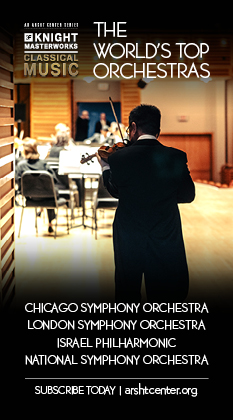Denève leads New World in powerful Prokofiev and a compelling new work

Gabriela Montero performed Rachmaninoff’s Piano Concerto No. 2 with Stéphane Denève and the New World Symphony Saturday night. Photo: Alex Marlow
Stéphane Denève keeps going from strength to strength. After leading a luminous sea-inspired program in September and a stylish, sparkling account of Mozart’s “Gran Partita” Serenade last weekend, the New World Symphony’s new artistic director took the podium Saturday night to conduct music from Prokofiev’s Romeo and Juliet in a performance that could scarcely be bettered.
Leading his own, mostly chronological suite from the ballet, Deènve demonstrated his ability to sustain momentum and imbue character into a score while maintaining fidelity to the musical text. He consistently draws a lustrous, burnished sonority from the New World strings that few conductors have matched. The power and blending of the brass was immediately evident in the opening crashing chords, portending the tragedy to come. In the “Minuet” Denève combined Prokofiev’s modernism and the classicism of court dance in perfect proportion. Vigorous phrasing from strings and winds projected the excitement before the ball of “Juliet the Child.” “Masks” emerged almost martial with the percussive backdrop strongly emphatic.
The heavy tread of the “Montagues and the Capulets” symbolized the feuding families’ bitter enmit, and Prokofiev’s distinctive scoring for the saxophone came through with clarity. Romeo and Juliet’s grand pas de deux had the full measure of sensuous, romantic ardor. The theme of “Friar Lawrence” resounded majestically and the “Death of Tybalt,” the swordplay brought forth the full panoply of instrumental colors. The strings’ intensity at the outset of “Romeo at Juliet’s Tomb” set the stage for the lovers’ final tragic death. The pianissimo Denève achieved at the conclusion put the final exclamation point on an account that gave full weight to the drama and luxuriant beauty of Prokofiev’s creation.
Throughout the performance, the underpinning of seven basses gave support to the work’s dark subtext. The New World fellows were in top form, all sections playing with brilliance and precision. The audience admirably held its applause until Denève lowered his hands, followed by a prolonged ovation. The conductor recognized both the first chair players and sections for plaudits.
The illness of mezzo-soprano Kelley O’Connor, who was to have sung Peter Lieberson’s Neruda Songs, necessitated a change of program in the concert’s first half. (Denève promised the audience that O’Connor will perform the work in a future season.) In place of the Lieberson, Gabriela Montero was soloist in Rachmaninoff’s Piano Concerto No. 2r. Rachmaninoff’s scoring is tailor made for the richness of corporate sound that Denève evokes from the orchestra, and he provided Montero with stalwart support.
In the opening Moderato, she captured much of the music’s romantic aura with a fine sense of line and accurately runs. Montero took a daringly slow tempo in the Adagio sostenuto, which she managed to sustain without allowing the melody to lose shape. The flute and clarinet solos in the introductory bars were exceptionally beautiful and Denève skillfully melded the orchestral fabric around the solo keyboard.
Montero exhibited a light touch in the Allegro scherzando finale and gave expansive weight and shape to the big romantic melody. The pianist’s accomplished reading was only undercut by the limitations of the house Yamaha on which she played. The instrument has a lightish sound that lacks the tonal heft of a Steinway (or, in former times, a Baldwin).
For an encore, Montero did one of her trademark improvisations on “Hava Nagila.” Combining Bach and Baroque ornaments with hints of Liszt and Rachmaninoff, her variants proved entertaining and concise.
The program opened with Visions of Cahokia by James Lee III. The 2022 score was commissioned and premiered by the St. Louis Symphony under Denève. (He is music director of the Missouri ensemble.) Lee’s previous orchestral vignette Sukkot through Orion’s Nebula was played by New World in 2011 and 2021. That Judaic-tinged opus displayed Lee’s tremendous ingenuity and fine ear for instrumental coloration.
Cahokia proves he is not a one-hit wonder. Lee’s three- movement, twelve-minute suite is a portrait of a civilization of native American tribes near St. Louis that flourished around 300 AD, peaking to a population of 30,000 around 1300 AD.
The performance was accompanied by projections designed by Michael Matamoros based on the archeology archives at the University of North Carolina, Chapel Hill. Since Lee’s music radiates cinematic scope, the visual component seemed organic rather than obtrusive.
The initial “Cahokia’s Dawn” pictures the tribes’ journey to the new land. Huge dynamic contrasts from whispered strings to brass and percussion blasts that raised the roof make way for the skittery melodic fragments of flutes, clarinets, and oboes. “Na Yimmi” (second movement) is a Choctaw Indian word for faith and the soft, lushly textured strings and accompanying harp radiate reverence.
A kaleidoscope of explosive fanfares and more delicate hues engulf “Chukoshkomo,” bringing the work to a joyous coda. Projections of a city rising in the countryside and sculptures enhanced the exciting music.
Lee’s well-constructed score deserves standard repertoire status. The composer, who was rousingly received by a nearly full house, could not have wished for a better performance. Hopefully, this was a harbinger of significant new music that will grace programs in the aborning Denève era.
The program will be repeated 2 p.m. Sunday at the New World Center in Miami Beach. nws.edu
Posted in Performances
One Response to “Denève leads New World in powerful Prokofiev and a compelling new work”
Leave a Comment
Sun Oct 15, 2023
at 12:25 pm
1 Comment




Posted Oct 16, 2023 at 10:25 am by Hubert
I was wondering about that piano! I was sitting right in front of the performer and the piano sounded suspect. I am really very surprised that the NWS does not have a higher quality instrument.